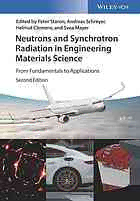
Neutrons and synchrotron radiation in engineering materials science : from fundamentals to applications PDF
Preview Neutrons and synchrotron radiation in engineering materials science : from fundamentals to applications
NeutronsandSynchrotronRadiation inEngineeringMaterialsScience Neutrons and Synchrotron Radiation in Engineering Materials Science FromFundamentalstoApplications EditedbyPeterStaron,AndreasSchreyer,HelmutClemens,and SveaMayer SecondEdition TheEditors AllbookspublishedbyWiley-VCHare carefullyproduced.Nevertheless,authors, Dr.PeterStaron editors,andpublisherdonotwarrantthe Helmholtz-ZentrumGeesthacht informationcontainedinthesebooks, InstituteofMaterialsResearch includingthisbook,tobefreeoferrors. MaxPlanck-Str.1 Readersareadvisedtokeepinmindthat 21502Geesthacht statements,data,illustrations,procedural Germany detailsorotheritemsmayinadvertently beinaccurate. Prof.Dr.AndreasSchreyer LibraryofCongressCardNo.:appliedfor EuropeanSpallationSourceERIC P.O.Box176 22100Lund BritishLibraryCataloguing-in-Publication Sweden Data Acataloguerecordforthisbookisavail- ablefromtheBritishLibrary. Prof.HelmutClemens MontanuniversitätLeoben DepartmentofPhysicalMetallurgy Bibliographicinformationpublishedby andMaterialsTesting theDeutscheNationalbibliothek Franz-Josef-Straße18 TheDeutscheNationalbibliothek 8700Leoben liststhispublicationintheDeutsche Austria Nationalbibliografie;detailed bibliographicdataareavailableonthe Internetat<http://dnb.d-nb.de>. Dr.SveaMayer MontanuniversitätLeoben DepartmentofPhysicalMetallurgy ©2017Wiley-VCHVerlagGmbH&Co. andMaterialsTesting KGaA,Boschstr.12,69469Weinheim, Franz-Josef-Straße18 Germany 8700Leoben Austria Allrightsreserved(includingthoseof translationintootherlanguages).Nopart Cover ofthisbookmaybereproducedinany Airplane:fotolia/Gudellaphoto form – byphotoprinting,microfilm,or Car:Porsche anyothermeans – nortransmittedor translatedintoamachinelanguage withoutwrittenpermissionfromthe publishers.Registerednames,trademarks, etc.usedinthisbook,evenwhennot specificallymarkedassuch,arenottobe consideredunprotectedbylaw. PrintISBN:978-3-527-33592-3 ePDFISBN:978-3-527-68451-9 ePubISBN:978-3-527-68450-2 MobiISBN:978-3-527-68449-6 oBookISBN:978-3-527-68448-9 CoverDesign SchulzGrafik-Design, Fußgönheim,Germany Typesetting SPiGlobal,Chennai,India PrintingandBinding Printedonacid-freepaper v Contents ListofContributor XVII PrefacetoSecondEdition XXIII PartI General 1 1 MicrostructureandPropertiesofEngineeringMaterials 3 HelmutClemens,SveaMayer,andChristinaScheu 1.1 Introduction 3 1.2 Microstructure 4 1.2.1 CrystalDefects 7 1.2.2 Grain(Phase)BoundariesandTwins 7 1.2.3 PrecipitatesandDispersions 8 1.3 MicrostructureandProperties 10 1.4 MicrostructuralCharacterization 12 References 19 2 InternalStressesinEngineeringMaterials 21 AnkeKaysser-Pyzalla 2.1 Definition 21 2.1.1 StressTensor,StrainTensor,andElasticityTensor 21 2.1.1.1 StressTensor 21 2.1.1.2 StrainTensor 22 2.1.2 Definitions,ResidualStresses 23 2.1.2.1 StressEquilibrium 23 2.1.2.2 ResidualMacro-andMicrostresses 24 2.2 OriginofResidualMacro-andMicrostresses 25 2.2.1 ResidualStressFormationinPrimaryFormingProcesses 26 2.2.2 ResidualStressFormationinHeatTreatmentProcesses 28 2.2.2.1 ResidualStressesinaMaterialwithoutPhaseTransformation(PureCooling ResidualStresses) 29 2.2.2.2 ResidualStressesinaMaterialwithPhaseTransformation 30 2.2.2.3 ResidualStressFormationinSurface-HardeningProcesses(Nitriding, Carbo-Nitriding,andCaseHardening) 32 2.2.3 ResidualStressFormationinFormingProcesses 32 vi Contents 2.2.3.1 Deep-RollingResidualStresses 33 2.2.3.2 ColdExtrusionResidualStresses 34 2.2.4 ResidualStressFormationinMetalCuttingManufacturing 36 2.2.4.1 GrindingResidualStresses 37 2.2.5 ResidualStressFormationinJoiningProcesses 39 2.2.6 ResidualStressFormationinCoatings 43 2.3 Relevance 45 2.3.1 FailureduetoResidualStressFormationorResidualStressReliefInducedby TemperatureChanges 46 2.3.2 InfluenceofResidualStressesonComponentFailureunderStaticand DynamicMechanicalLoads 47 2.3.3 InfluenceofResidualStressesonComponentFailureinCorrosive Environments 49 2.3.4 InfluenceofResidualStressesonWear 49 References 51 3 TexturesinEngineeringMaterials 55 HeinzG.BrokmeierandSangbongYi 3.1 Introduction 55 3.2 MeasurementofPreferredOrientations 58 3.3 PresentationofPreferredOrientations 59 3.3.1 PoleFigure 60 3.3.2 OrientationDistributionFunction 62 3.3.3 InversePoleFigures 62 3.4 InterpretationofTextures 62 3.5 Errors 67 3.5.1 GrainStatistics 67 3.5.2 PoleFigureCoverage 68 References 71 4 PhysicalPropertiesofPhotonsandNeutrons 73 AndreasSchreyer 4.1 Introduction 73 4.2 InteractionofX-rayPhotonsandNeutronswithIndividualAtoms 74 4.2.1 Neutrons 75 4.2.2 X-rays 76 4.3 ScatteringofX-rayPhotonsandNeutronsfromEnsemblesofAtoms 79 Acknowledgment 81 References 81 5 RadiationSources 83 5.1 GenerationandPropertiesofNeutrons 83 InaLommatzsch,WolfgangKnop,PhilippK.Pranzas,andPeterSchreiner 5.1.1 Introduction 83 5.1.2 GenerationofNeutrons 83 5.1.2.1 ResearchReactors 83 5.1.2.2 SpallationSources 87 Contents vii 5.1.3 Instrumentation 87 5.1.3.1 StructureResearch 89 5.1.3.2 Large-ScaleStructures 89 5.1.3.3 Spectroscopy 89 5.1.3.4 ImagingandAnalysis 89 5.1.3.5 ParticlePhysics 89 References 90 5.2 ProductionandPropertiesofSynchrotronRadiation 90 RolfTreusch 5.2.1 Introduction 90 5.2.2 PropertiesofSynchrotronRadiation 92 5.2.3 SourcesofSynchrotronRadiation 96 5.2.3.1 BendingMagnets 97 5.2.3.2 WigglersandUndulators 98 5.2.4 Outlook:FreeElectronLasers 100 5.2.5 Summary 102 References 102 PartII Methods 105 6 StressAnalysisbyAngle-DispersiveNeutronDiffraction 107 PeterStaron 6.1 Introduction 107 6.2 DiffractometerforResidualStressAnalysis 108 6.2.1 SetupofaDiffractometerforStrainScanning 108 6.2.2 Monochromator 109 6.2.3 SlitSystem 110 6.2.4 SamplePositioning 111 6.2.5 Detector 111 6.3 MeasurementandDataAnalysis 112 6.3.1 GageVolumeandSamplePositioning 112 6.3.2 DataReductionandAnalysis 113 6.3.2.1 DataReductionandPeakFitting 113 6.3.2.2 CalculationofStresses 114 6.3.2.3 MacroandMicrostresses 115 6.3.2.4 Stress-FreeReference 116 6.4 Examples 116 6.4.1 ResidualStressesinFrictionStirWeldedAluminumSheets 116 6.4.2 ResidualStressesinWater-QuenchedTurbineDisks 117 6.5 SummaryandOutlook 120 References 120 7 StressAnalysisbyEnergy-DispersiveNeutronDiffraction 123 JavierSantisteban 7.1 Introduction 123 7.2 Time-of-FlightNeutronDiffraction 123 viii Contents 7.2.1 TOFPeakShapeandDataAnalysisPackages 124 7.3 TOFStrainScanners 126 7.3.1 CountingTimesandResolution 128 7.3.2 NeutronOpticsandTimeFocusing 130 7.4 AVirtualLaboratoryforStrainScanning 131 7.5 TypeIIStresses:EvolutionofIntergranularStresses 134 7.6 TypeIIIStresses:DislocationDensities 135 7.7 StrainImagingbyEnergy-DispersiveNeutronTransmission 138 7.8 Conclusions 140 Acknowledgments 141 References 141 8 ResidualStressAnalysisbyMonochromaticHigh-EnergyX-rays 145 RenéV.Martins 8.1 BasicSetups 145 8.2 PrincipleofSlitImagingandDataReconstruction 148 8.3 TheConicalSlit 149 8.3.1 WorkingPrinciple 149 8.3.2 Capabilities 149 8.3.3 Example 151 8.4 TheSpiralSlit 152 8.4.1 FunctionalPrinciple 152 8.4.2 Capabilities 152 8.4.3 Example 153 8.5 SimultaneousStrainMeasurementsinIndividualBulkGrains 155 8.6 CoarseGrainEffects 156 8.7 AnalysisofDiffractionDatafromAreaDetectors 157 8.8 MatrixforComparisonandDecisionTakingWhichTechniquetoUsefora SpecificProblem 158 References 159 9 ResidualStressAnalysisbyEnergy-DispersiveSynchrotronX-ray Diffraction 161 ChristophGenzelandManuelaKlaus 9.1 Introduction 161 9.2 FundamentalsofEnergy-DispersiveX-rayDiffractionStressAnalysis 162 9.2.1 TheBasicEquationofEnergy-DispersiveX-rayDiffraction 162 9.2.2 Near-SurfaceDepthProfilingintheEnergy-DispersiveDiffraction Mode 162 9.2.3 PrinciplesofDepth-ResolvedX-rayStressAnalysisandApplicationtothe Energy-DispersiveCaseofDiffraction 164 9.3 ExperimentalSetup 167 9.4 ExamplesforEnergy-DispersiveStressAnalysis 168 9.4.1 NearSurfaceResidualStressDepthProfiling 168 9.4.2 FastInsituStressAnalysisbyMeansofEnergy-DispersiveDiffraction 171 9.5 FinalRemarks 173 References 175 Contents ix 10 TextureAnalysesbySynchrotronX-raysandNeutrons 179 SangbongYi,WeiminGan,andHeinzG.Brokmeier 10.1 TextureMeasurementsonLaboratoryScale 179 10.1.1 X-rayDiffraction 179 10.1.2 ElectronDiffraction 181 10.2 TextureMeasurementsatLargeScaleFacilities 182 10.2.1 NeutronDiffraction 182 10.2.2 TextureAnalysisUsingSynchrotronX-rays 185 10.2.3 ExamplesofTextureAnalysesUsingNeutrons andSynchrotronX-rays 189 10.2.3.1 LocalTextureMeasurementofaFrictionWeldedRod 189 10.2.3.2 GlobalTextureinCuWire 190 10.2.3.3 InsituTextureMeasurementofSteelatElevatedTemperature 191 10.2.3.4 InsituTextureMeasurementunderLoading 192 10.3 Conclusion 193 References 194 11 BasicsofSmall-AngleScatteringMethods 197 PhilippK.Pranzas 11.1 Introduction 197 11.2 CommonFeaturesofaSASInstrument 197 11.3 Contrast 198 11.4 ScatteringCurve 198 11.5 PowerLaw/ScatteringbyFractalSystems 200 11.6 GuinierandPorodApproximations 201 11.7 MacroscopicDifferentialScatteringCross-section 202 11.8 ModelCalculationofSizeDistributions 202 11.9 MagneticStructures 203 References 204 12 Small-AngleNeutronScattering 207 PhilippK.PranzasandAndréHeinemann 12.1 Introduction 207 12.2 NanocrystallineMagnesiumHydridefortheReversibleStorageof Hydrogen 208 12.3 PrecipitatesinSteel 210 12.4 SiO NanoparticlesinaPolymerMatrix–AnIndustrialApplication 213 2 12.5 GreenSurfactants 213 Acknowledgments 215 References 215 13 AnomalousSmall-AngleX-rayScattering 217 UllaVainio 13.1 Introduction 217 13.2 Theory 218 13.2.1 ScatteringPowerofElements 218 13.2.2 ContrastVariation 219 x Contents 13.2.3 PartialStructureFactorFormalism 219 13.2.4 Model-DependentASAXS 221 13.2.5 SubtractionMethod 221 13.3 Experiments 223 13.4 Example:ASAXSonCatalystNanoparticles 223 13.5 SummaryandOutlook 223 References 224 14 Imaging 227 WolfgangTreimer 14.1 Radiography 227 14.1.1 Fundamentals 227 14.1.2 InteractionsofNeutronswithMatter 228 14.1.3 Geometries 230 14.1.4 ResolutionFunctions 232 14.1.5 ImageDegradation 235 14.1.6 OtherImagingTechniques 236 14.1.6.1 EnergyDispersiveRadiography 236 14.1.6.2 Real-TimeRadiography 238 14.1.6.3 PhaseContrastRadiography 239 14.2 Tomography 240 14.2.1 MathematicalIntroduction 240 14.2.2 SliceTheorem,ShannonTheorem 241 14.2.3 ImageReconstruction 243 14.3 NewDevelopmentsinNeutronTomography 244 14.3.1 Refraction 246 14.3.2 Ultra-SmallAngleNeutronTomography 247 14.3.3 RadiographyandTomographywithPolarizedNeutrons 249 References 250 15 NeutronandSynchrotron-Radiation-BasedImagingforApplications inMaterialsScience–FromMacro-toNanotomography 253 FelixBeckmann 15.1 Introduction 253 15.1.1 Attenuation-ContrastProjections 253 15.1.2 Phase-ContrastProjections 254 15.1.3 Phase-EnhancedProjections 255 15.1.4 DirectPhase-ContrastProjections 255 15.1.5 IndirectPhase-ContrastProjections 255 15.2 Parallel-BeamTomography 256 15.2.1 MeasurementandReconstruction 256 15.2.2 DensityResolutionandDetectorQuality 258 15.2.3 DataEvaluationandVisualization 258 15.3 MacrotomographyUsingNeutrons 258 15.3.1 ExperimentalSetup 258 15.3.2 MeasurementsandResults 260 Contents xi 15.4 MicrotomographyUsingSynchrotronRadiation 264 15.4.1 BeamlineOptics 265 15.4.2 ExperimentalSetup 267 15.5 SummaryandOutlook 271 References 271 16 𝛍-TomographyofEngineeringMaterials 275 AstridHaibelandJuliaHerzen 16.1 Introduction 275 16.2 AdvantageofSynchrotronTomography 275 16.3 Applicationsand3DImageAnalysis 276 16.3.1 DischargingProcessesinAlkalineCells 276 16.3.2 MicrostructuralInvestigationsofNb SnMulti-filamentarySuperconductor 3 Wires 278 16.3.3 InfluenceoftheFoamingAgentonMetallicFoamStructures 280 16.3.4 ExvivoGrating-BasedPhaseContrastImagingofHumanCarotid Arteries 281 16.4 ImageArtifacts 282 16.4.1 RingArtifacts 282 16.4.2 ImageNoise 284 16.4.3 EdgeArtifacts 284 16.4.4 MotionArtifacts 285 16.4.5 CenteringErrorsoftheRotationAxis 286 16.5 Summary 286 References 286 PartIII NewandEmergingMethods 291 17 3DX-rayDiffractionMicroscope 293 HenningF.Poulsen,WolfgangLudwig,andSørenSchmidt 17.1 BasicSetupandStrategy 294 17.1.1 The3DXRDMicroscope 296 17.2 IndexingandCharacterizationofAveragePropertiesofEachGrain 296 17.2.1 ApplicationI:NucleationandGrowthStudies 297 17.2.2 ApplicationII:PlasticDeformation 298 17.2.3 ApplicationIII:StudiesofSubgrainsandNanocrystallineMaterials 299 17.3 MappingofGrainsandOrientations 300 17.3.1 ModeIII:MappingGrainsinUndeformedSpecimens 300 17.3.2 ModeIV:MappingOrientationsinDeformedSpecimens 301 17.3.3 ApplicationI:Recrystallization 302 17.3.4 ApplicationII:GrainGrowth 303 17.4 Combining3DXRDandTomography 304 17.4.1 GrainMappingbyTomography 304 17.5 Outlook 305 References 306
